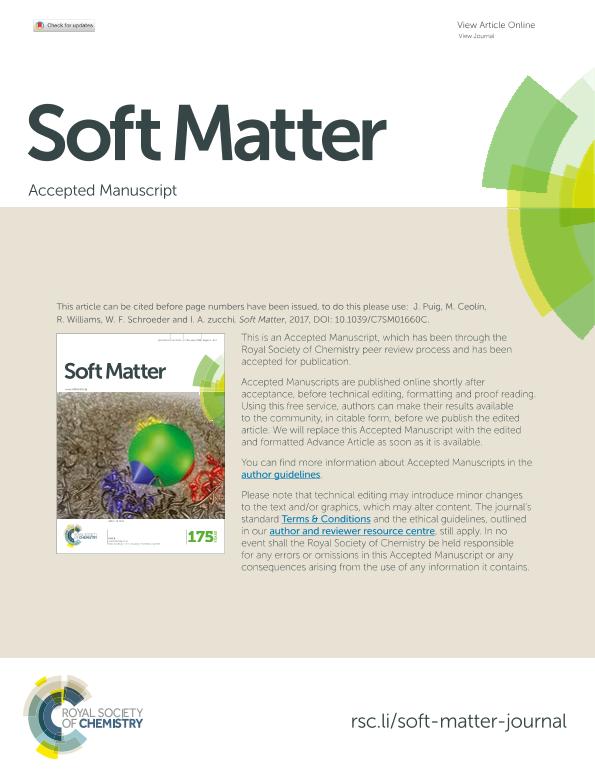Artículo
Controlling the generation of bilayer and multilayer vesicles in block copolymer/epoxy blends by a slow photopolymerization process
Puig, Julieta ; Ceolin, Marcelo Raul
; Ceolin, Marcelo Raul ; Williams, Roberto Juan Jose
; Williams, Roberto Juan Jose ; Schroeder, Walter Fabian
; Schroeder, Walter Fabian ; Zucchi, Ileana Alicia
; Zucchi, Ileana Alicia
 ; Ceolin, Marcelo Raul
; Ceolin, Marcelo Raul ; Williams, Roberto Juan Jose
; Williams, Roberto Juan Jose ; Schroeder, Walter Fabian
; Schroeder, Walter Fabian ; Zucchi, Ileana Alicia
; Zucchi, Ileana Alicia
Fecha de publicación:
09/2017
Editorial:
Royal Society of Chemistry
Revista:
Soft Matter
ISSN:
1744-683X
Idioma:
Inglés
Tipo de recurso:
Artículo publicado
Resumen
Vesicles are a highly attractive morphology to achieve in micellar dispersions of block copolymers (BCP) in epoxy thermosets due to the fact that small amounts can affect a large volume fraction of the matrix, a fact that is important for toughening purposes. However, generating vesicles in epoxy matrices requires operating in a narrow range of formulations and processing conditions. In this report, we show that block-copolymer vesicles dispersed in an epoxy matrix could be obtained through a sphere-to-cylinder-to-vesicle micellar transition induced by visible-light photopolymerization at room temperature. A 10 wt% colloidal solution of poly(ethylene-co-butene)-block-poly(ethylene oxide) (PEB-b-PEO) block copolymer (BCP) in an epoxy monomer (DGEBA) self-assembled into spherical micelles as shown by small-angle X-ray scattering (SAXS). During a slow photopolymerization of the epoxy monomer carried out at room temperature, a sphere-to-cylinder-to-vesicle transition took place as revealed by in situ SAXS and TEM images. This was driven by the tendency of the system to reduce the local interfacial curvature as a response to a decrease in the miscibility of PEO blocks in the polymerizing epoxy matrix. When the BCP concentration was increased from 10 to 20 and 40 wt%, the final structure evolved from bilayer vesicles to multilayer vesicles and to lamellae, respectively. In particular, for 20 wt% PEB-b-PEO, transient structures such as partially fused multilayered vesicles were observed by TEM, giving insight into the growth mechanism of multilayer vesicles. On the contrary, when a relatively fast thermal polymerization was performed at 80 °C, the final morphology consisted of kinetically trapped spherical and cylindrical micelles. Hopefully, this study will lead to new protocols for the preparation of vesicles dispersed in epoxy matrices in a controlled way.
Palabras clave:
Photopolymerization
,
Block Copolymer
,
Vesicles
,
Epoxy Matrix
Archivos asociados
Licencia
Identificadores
Colecciones
Articulos(INIFTA)
Articulos de INST.DE INV.FISICOQUIMICAS TEORICAS Y APLIC.
Articulos de INST.DE INV.FISICOQUIMICAS TEORICAS Y APLIC.
Articulos(INTEMA)
Articulos de INST.DE INV.EN CIENCIA Y TECNOL.MATERIALES (I)
Articulos de INST.DE INV.EN CIENCIA Y TECNOL.MATERIALES (I)
Citación
Puig, Julieta; Ceolin, Marcelo Raul; Williams, Roberto Juan Jose; Schroeder, Walter Fabian; Zucchi, Ileana Alicia; Controlling the generation of bilayer and multilayer vesicles in block copolymer/epoxy blends by a slow photopolymerization process; Royal Society of Chemistry; Soft Matter; 13; 40; 9-2017; 7341-7351
Compartir
Altmétricas



